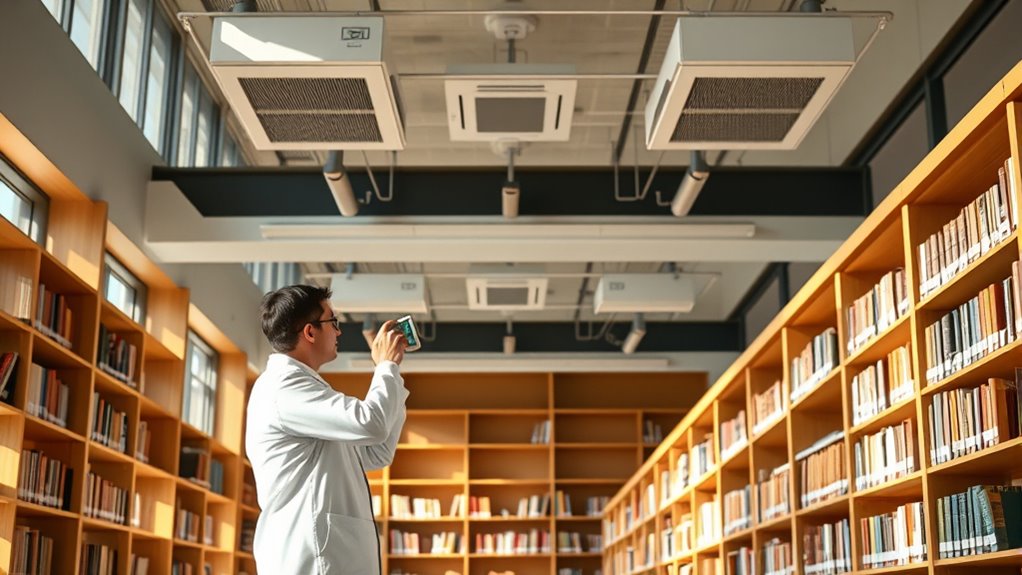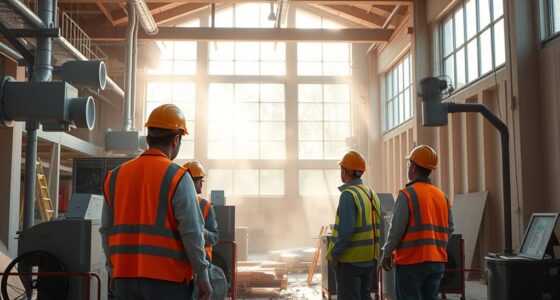To maintain good air quality in your library or archives, implement pollution control measures like high-quality filters, sealing gaps, and using targeted air purifiers. Make certain your ventilation systems facilitate continuous air exchange, control humidity, and include advanced filtration to remove microscopic pollutants. Regular maintenance and inspections are essential to keep systems functioning at their best, while environmental monitoring tools help you track air quality and adjust as needed. Keep exploring to discover how to create a safe, healthy environment for your collections and visitors.
Key Takeaways
- Implement high-quality filtration and sealing measures to prevent outdoor pollutants from entering indoor environments.
- Use advanced ventilation systems with automated controls to ensure continuous air exchange and pollutant dilution.
- Regularly maintain and inspect filters and ventilation equipment to sustain optimal indoor air quality.
- Utilize environmental monitoring tools to track pollutant levels, humidity, and temperature for proactive management.
- Integrate pollution control and ventilation strategies into a comprehensive indoor air quality management plan.

Have you ever wondered how cities improve the air we breathe? It’s a complex process that involves numerous strategies, especially when it comes to maintaining the air quality inside buildings like libraries and archival facilities. These spaces house sensitive materials that can be easily damaged by pollutants, so implementing effective air quality strategies is indispensable. One of the most critical components of these strategies is pollution control, which focuses on reducing the entry of harmful substances into the indoor environment. This can involve installing high-quality filters on air intake systems, sealing gaps and cracks to prevent outdoor pollutants from seeping in, and using air purifiers that target specific contaminants. These measures help guarantee that dust, volatile organic compounds (VOCs), and other airborne pollutants stay at bay, creating a safer environment for both the materials and the people who work or visit these facilities.
A key element in maintaining good indoor air quality is the use of ventilation systems. Proper ventilation isn’t just about bringing fresh air inside; it’s about continuously exchanging indoor air with filtered outdoor air to dilute and remove indoor pollutants. In libraries and archives, the design of ventilation systems must prioritize both air quality and humidity control, because excessive moisture can lead to mold growth and deterioration of paper, textiles, and other sensitive materials. Modern ventilation systems incorporate advanced filtration units that trap microscopic particles, pollen, and chemical vapors, ensuring that the air circulating inside remains clean. These systems can be automated to adjust airflow based on occupancy levels or indoor air quality sensors, providing a dynamic approach to pollution control.
Additionally, maintaining these systems regularly is essential. Filters need to be replaced or cleaned according to manufacturer specifications, and the entire ventilation setup should undergo routine inspections to identify and address any issues promptly. Proper maintenance not only prolongs the lifespan of the equipment but also guarantees that the air quality remains consistently high. Implementing environmental monitoring tools helps you track pollutants, humidity, and temperature levels in real-time, allowing you to make informed decisions about when to adjust ventilation rates or perform maintenance. In essence, combining robust pollution control measures with efficient ventilation systems creates a resilient environment that protects valuable collections and supports the health of staff and visitors.
Frequently Asked Questions
How Do Air Quality Standards Differ Between Libraries and Archives?
You’ll find that air quality standards differ between libraries and archives mainly to protect environmental impact and staff health. Archives require stricter controls because their materials are more sensitive to pollutants, so you’ll implement lower VOC limits and better humidity controls. In libraries, standards focus on reducing dust and mold to prevent damage and ensure a healthy environment for staff and visitors. Adjusting standards based on activity and material sensitivity helps safeguard both environments effectively.
What Are the Most Common Pollutants Found in Archival Storage Environments?
Imagine walking into a quiet, dusty vault filled with ancient papers and fragile photographs. You’ll find indoor allergens like mold spores and dust mites lurking behind the scenes, along with chemical contaminants such as acetic acid and formaldehyde from aging materials. These pollutants can cause deterioration and health issues, so maintaining air quality with proper filtration and monitoring becomes essential to preserve your valuable collections and ensure a safe environment.
How Often Should Air Quality Be Monitored in These Facilities?
You should monitor air quality regularly, ideally every three to six months, to guarantee a healthy environment. Keep in mind that monitoring frequency may vary based on your facility’s size and materials stored. Make sure your equipment is properly calibrated before each use to assure accurate readings. Consistent monitoring helps detect pollutants early, allowing you to take prompt action and maintain ideal preservation conditions for your collections.
Are There Specific Air Purification Systems Recommended for Historic Collections?
You need the absolute best air purification systems for your historic collections, ones that can handle the tiniest particles and pollutants. For historic preservation, multi-stage HEPA filters combined with activated carbon are essential, removing dust, mold spores, and harmful gases. Environmental controls like humidity and temperature regulators work hand-in-hand with these systems, creating a fortress of preservation. Don’t settle for less—protect your invaluable collections with top-tier, proven air purification solutions.
How Does Climate Control Impact Air Quality in Archival Settings?
Climate control notably impacts air quality in archival settings by maintaining proper humidity regulation and temperature stabilization. You should aim for consistent, ideal levels to prevent mold growth, corrosion, and deterioration of your collections. Proper climate control reduces airborne pollutants and dust, creating a safer environment. By actively managing these factors, you protect your materials from damage and preserve their integrity for future generations.
Conclusion
So, next time you step into a library or archive, remember: your quiet sanctuary isn’t just for silence, but also for battling airborne villains. By implementing these air quality strategies, you’re fundamentally becoming the superhero your precious collections deserve—minus the cape, of course. Keep those pollutants at bay and enjoy your reading without worrying about your favorite book turning into a moldy relic. After all, who knew good air could be so heroic?









